

A Massachusetts Company Claims to Be Close to a Solid-State Battery. In Brief Could we finally be close to having a solid-state battery?

One small Massachusetts company claims that their new material may be the key to unlocking this technology — prompting an outpouring of investment. New Investments According to Axios, technology giants like Samsung and Dyson have collectively invested $65 million in Massachusetts-based Ionic Materials. This enormous vote of confidence is a bit shocking, as most people probably haven’t even heard of the small company before. The company, established in 1986, seems to be making unique progress in solid-state technology. So far, Ionic Materials’ researchers have claimed three major breakthroughs. Second, they say that their material works at an impressive five volts and can be made simply and cheaply. Solid State Ionic Materials seems to have a leg up on competitors with its unique, cheap, and simple-to-produce material.
They are safer than current batteries, for one thing. Scientists Have Made a New Kind of Invisibility Cloak. Bending Light Concealing objects in direct light is already a difficult feat.
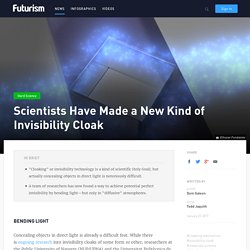
While there is ongoing research into invisibility cloaks of some form or other, researchers at the Public University of Navarre (NUP/UPNA) and the Universitat Politècnica de València (UPV) are taking a not-so-straightforward approach. In particular, they are interested in developing a cloaking mechanism that works by bending light. The team, whose work is published in the journal Physical Review A, has worked on simulations of an invisibility technology that conceals objects in diffusive atmospheres. Researchers create ultrathin invisibility cloak. In Brief Researchers have devised an ultra-thin invisibility 'skin' cloak that can conform to the shape of an object and conceal it from detection with visible light.
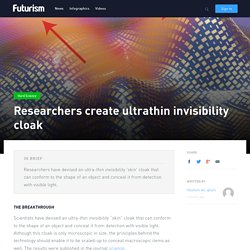
The Breakthrough. Scientists Create New Invisible Material. Newly Discovered Biological Material Stronger Than Kevlar. Scientists Have Made Concrete Using Plastic Waste. Scientists discover whole new state of matter. Most people are familiar with some of the common states of matter: solids, liquids and gases.
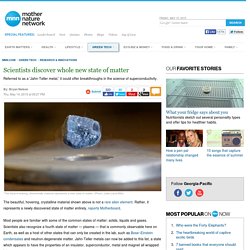
Scientists also recognize a fourth state of matter — plasma — that is commonly observable here on Earth, as well as a host of other states that can only be created in the lab, such as Bose–Einstein condensates and neutron-degenerate matter. Jahn-Teller metals can now be added to this list, a state which appears to have the properties of an insulator, superconductor, metal and magnet all wrapped into one. It's the material's superconductivity which might be the most interesting trait, however. Matter will be created from light within a year, claim scientists. Researchers have worked out how to make matter from pure light and are drawing up plans to demonstrate the feat within the next 12 months.

The theory underpinning the idea was first described 80 years ago by two physicists who later worked on the first atomic bomb. At the time they considered the conversion of light into matter impossible in a laboratory. But in a report published on Sunday, physicists at Imperial College London claim to have cracked the problem using high-powered lasers and other equipment now available to scientists. Super Materials. Smart Electronic Concrete. Scientists transform cement into liquid metal. It's not the same as turning lead into gold, but scientists at the Illinois-based Argonne National Laboratory and the Japan Synchrotron Radiation Research Institute/SPring-8 have developed a method for turning cement into a liquid metal semiconductor.

The process sounds like a mad scientist's invention. It involves equipment like an aerodynamic levitator and a carbon dioxide laser beam. The levitator uses gas pressure to keep the material out of contact with any container surfaces. The carbon dioxide laser beam can heat the material to 3,632 degrees Fahrenheit. Liquid metal brings shape-shifting robot a step closer - tech - 10 March 2015. Video: Self-fuelled liquid metal motor Hasta la vista, baby.
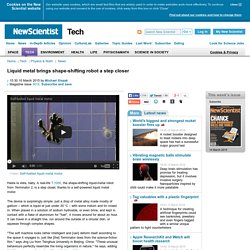
A real-life T-1000, the shape-shifting liquid-metal robot from Terminator 2, is a step closer, thanks to a self-powered liquid metal motor. The device is surprisingly simple: just a drop of metal alloy made mostly of gallium – which is liquid at just under 30 °C – with some indium and tin mixed in. When placed in a solution of sodium hydroxide, or even brine, and kept in contact with a flake of aluminium for "fuel", it moves around for about an hour. It can travel in a straight line, run around the outside of a circular dish, or squeeze through complex shapes. "The soft machine looks rather intelligent and [can] deform itself according to the space it voyages in, just like [the] Terminator does from the science-fiction film," says Jing Liu from Tsinghua University in Beijing, China. When they first saw the drop move, Liu and colleagues weren't sure how it was able to do so. Terminator-Like "Smart Liquid Metal" May Be The First Step In A New Arms Race.
Graphene Is The Strongest Material In The World Even When It Has Defects, Research Finds. Clean Power Published on June 2nd, 2013 | by James Ayre June 2nd, 2013 by James Ayre Graphene is the strongest material in the world, even when it has notable defects, new research has found.
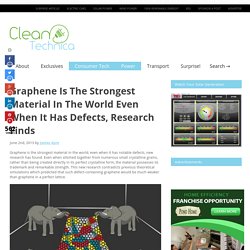
Even when stitched together from numerous small crystalline grains, rather than being created directly in its perfect crystalline form, the material possesses its trademark and remarkable strength. Caltech scientists unlock secrets of graphene, a revolutionary wonder material - Futurism. The 10 strangest facts about graphene. When first discovered, graphene was odd.

Now odd is too small a word for a material seemingly set on winning all the records a material can win. In the first part of our series, we looked at what graphene is and how it was discovered. In part two, we explored the different techniques we can use to make graphene. But what is it that makes this material so remarkable? Here are 10 of the strangest facts about graphene. 1. So says Professor James (Jim) Tour of Rice University in Texas, and who are we to argue with that? Everyone you ask about graphene's amazing properties says the same thing: it is really hard to pick one feature when the material is so astonishing. 2. Chemists fabricate 'impossible' material. (PhysOrg.com) -- When atoms combine to form compounds, they must follow certain bonding and valence rules.
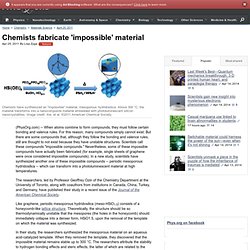
For this reason, many compounds simply cannot exist. But there are some compounds that, although they follow the bonding and valence rules, still are thought to not exist because they have unstable structures. Scientist Creates Diamonds From Peanut Butter. Diamonds are typically created more than 800 kilometers (500 miles) below Earth’s surface when temperatures over 2200 degrees Celsius (4000 degrees Fahrenheit) and pressure 1.3 million times greater than the atmosphere combine and crystallize carbon into the clear white stone we all know.
Synthetic diamonds can replicate the process in a few short days, creating diamonds that are less politically-charged for use in jewelry, electronics, manufacturing, and more. Dan Frost of Germany's Bayerisches Geoinstitut has been creating diamonds out of a rather unlikely source of carbon: peanut butter. Frost explained his process to BBC Future’s David Robinson. While it might sound a bit on the ridiculous side, Frost’s process is allowing him to explore the composition of Earth’s mantle, and even challenge some long-standing assumptions about where some of these elemental components originated. Scientists Create New Invisible Material. Grey goo. Grey goo (also spelled gray goo) is a hypothetical end-of-the-world scenario involving molecular nanotechnology in which out-of-control self-replicating robots consume all matter on Earth while building more of themselves,[1][2] a scenario that has been called ecophagy ("eating the environment").[3] The original idea assumed machines were designed to have this capability, while popularizations have assumed that machines might somehow gain this capability by accident.
Definition[edit] The term was first used by molecular nanotechnology pioneer Eric Drexler in his book Engines of Creation (1986). In Chapter 4, Engines Of Abundance, Drexler illustrates both exponential growth and inherent limits (not gray goo) by describing nanomachines that can function only if given special raw materials: